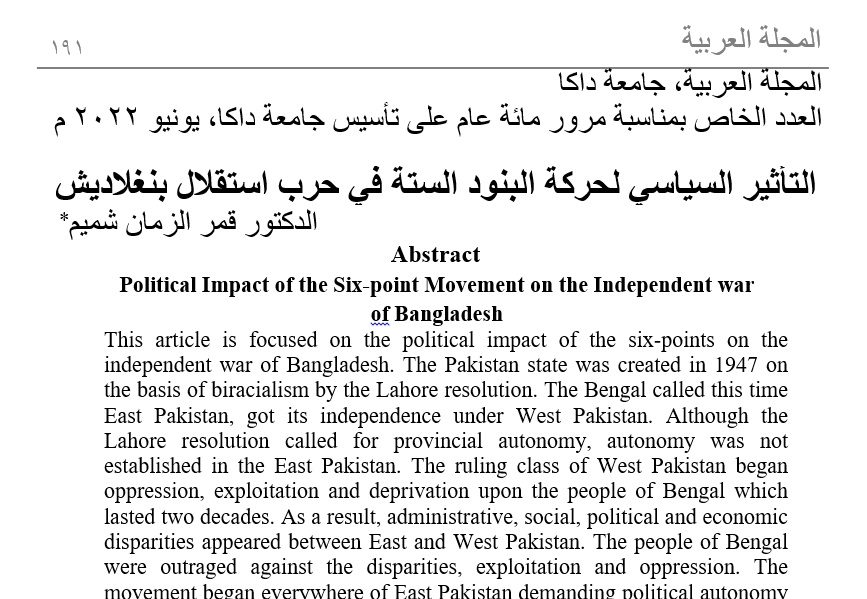Political Impact of the Six-point Movement on the Independent war of Bangladesh
DOI:
https://doi.org/10.62295/mazallah.v23i26.68Keywords:
Six-point Movement, Background, Reaction, Impact of six-pointAbstract
This article is focused on the political impact of the six-points on the independent war of Bangladesh. The Pakistan state was created in 1947 on the basis of biracialism by the Lahore resolution. The Bengal called this time East Pakistan, got its independence under West Pakistan. Although the Lahore resolution called for provincial autonomy, autonomy was not established in the East Pakistan. The ruling class of West Pakistan began oppression, exploitation and deprivation upon the people of Bengal which lasted two decades. As a result, administrative, social, political and economic disparities appeared between East and West Pakistan. The people of Bengal were outraged against the disparities, exploitation and oppression. The movement began everywhere of East Pakistan demanding political autonomy and economic equality.
The Awami League under the leadership of Bangabandhu Sheikh Mujibur Rahman played a vital role in this movement. On 5-6 February, 1966, a conference of the opposition was held in Lahore. Sheikh Mujib submitted to the subject committee six-points to include the issue in the agenda of conference. The proposal was rejected by the committee and Awami League under leadership of Sheikh Mujib boycotted the conference. Later Bangabandhu announced historical six points in a press conference. The inhabitant of East Pakistan received the six-points as a charter of freedom from disparities. They became united under the leadership of Bangabandhu and raised their sound for achieving the autonomy. But West Pakistan ruling class did not fulfill the demand of East Pakistan leaders. As a result, it turned to the movement of independence of Bengal from West Pakistan day by day. So six-points are considered a milestone on the road to Bangladesh's independence. This study tries to find out political impact of six-points which played a leading role to turn the movement into a struggle of independence.
References
خان، الدكتور دراج الرحمن، عواميليغير إيتيهاش (1949-1971م) (تاريخ رابطة عوامي (1949-1971م)). المجلد الأول. داكا: شاهيتيا بيلاش
تريبيدي، رابيندراناث، 1999م. سهاي دافا ثيكي بنغلاديش (بنغلاديش من البنود الستة). داكا: حقاني بابليشارس.
حسين، الدكتور أبو محمد دلوار، 2013م. بنغلاديشير إيتيهاش 1905-1971م (تاريخ بنغلاديش 1905-1971م). داكا: بيشوابيدياليا بروكاشوني.
حنان، محمد. 1987م. بنغلاديشير سهاترا أندولانير إيتيهاش (1953-1969م) (تاريخ حركة الطلاب لبنغلاديش (1953-1969م)). داكا: وارسي بروكاشوني.
الرشيد، هارون. 2016م. مولدهارار راجنيتي بنغلاديش عواميليغ (كاوونسيل 1949-1971م) (التيار السياسي لرابطة عوامي بنغلاديش (المجلس 1949-1971م)). داكا: بنغالة إيكاديمي.
السعيد، أبو. 1996م. عواميليغير إيتيهاش (1949-1971م) (تاريخ رابطة عوامي (1949-1971م)). داكا: أغامي بروكاشوني
Bhuyain, Md. Abdul Wadud, 1982. Emergence of Bangladesh & Role of Awami League. New Delhi: Vikas Publishing.
Jahan, Dr. Rounaq, 2001. Pakistan: Failure in National Integration. Dhaka: The University Press.
M. Rashiduzzaman, “The Awami League in the Political Development of Pakistan,” Asian Survey 10, No. 7 (July 1970): 574-587.
Islam, Sirajul (edited), 2003. Banglapedia. “Six-Point Programme”. V. 9, Dhaka: Asiatic Society. 318-319


